

Prompt by TheArtists
submerged in water prompts
very few results

very few results

8 months ago
A beautiful realistic portrait of a gorgeous Irish female reclining gracefully, half-submerged in a tranquil rock pool. She has long, braided raven black and pink mixed hair. She wears an elegant, sheer pink gown that shimmers in the sunlight, its delicate fabric clinging to her form and flowing into the water, and barefoot. A small waterfall cascades gently into the pool. Surrounding her are beautiful plants and colorful flowers, their colours stand out against the earthy tones of the rocks. In the distance, well known midevil England unfolds—castle and an old kingdom basking in the direct light of the sun. The scene 8K, high resolution, highly detailed, and high quality.

7 months ago
Create a hyper-realistic bird’s-eye view of a 16th-century pirate ship stranded in the middle of a flooded highway in Makassar, Indonesia. The massive ship, now very old, has tall sails that are no longer fully intact, with the wood and paint faded and weathered from time and exposure. The ship is surrounded by the floodwaters that have submerged the street, with elevated flyovers full of stopped cars due to a traffic jam caused by heavy rain. In the background, you can see the University of Makassar (UNM) campus building standing tall, and nearby, several Pinisi ships and small boats float helplessly in the rising floodwaters. The atmosphere is dramatic and chaotic, with dark clouds looming overhead, and the sky frequently pierced by lightning strikes that illuminate the scene. The rain is torrential, creating a misty fog over the city, while water ripples from the rain create an eerie reflection of the scene in the flooded streets. The contrast between the ancient pirate ship, the modern city with jammed traffic, and the presence of the Pinisi ships creates a surreal, cinematic effect. The stormy weather, the overwhelming flood, and the historical ship stranded in a modern setting evoke a sense of nature’s power and the unexpected clash of time and place.

8 months ago
Ultra-detailed half body portrait of a desert-hardened woman in her mid 20s, sun-weathered skin with natural freckles across her cheeks and blemishes over her body, keen hazel eyes adapted to scanning distant horizons, dark hair wrapped in a practical sand-colored shemagh that protects her neck and lower face, wearing layered desert survival gear - a loose fitting crop top underneath a weathered open tactical vest, revealing a flat, toned belly with defed abs, outie belly button. She wears loose low rise pants and a belt with multiple water container attachments, UV-protective goggles pushed up on her forehead, standing amid the ruins of a massive oil refinery complex half-buried by endless dunes of golden sand, towering rusted distillation columns rising like ancient monoliths from the desert floor, heat waves visibly distorting the air around corroded pipeline networks that snake through the dunes, scattered remnants of industrial machinery emerging from shifting sands - partially buried pressure vessels, sand-scoured storage tanks, and wind-polished metal structures, intense sunlight casting harsh shadows across her face through gaps in the deteriorating industrial framework, sand particles catching the light as they drift through the air, multiple layers of desert-industrial decay visible in the background - collapsed cooling towers creating artificial canyons, sand-filled processing units, and sun-bleached warning signs barely visible under layers of dust, abandoned vehicles half-submerged in sand drifts, occasional glints of metal where the wind has exposed buried equipment, photorealistic rendering with attention to material interactions between sand and metal - wind-polished surfaces, sand-carved patterns in steel, and sun-damaged materials, 8k resolution emphasizing the texture of each weather-beaten surface, technical perspective showing the massive scale of the industrial remains against the endless desert horizon, visible heat distortion in the distance where sky meets sand, subtle color variations in the sand showing mineral content and age of dune
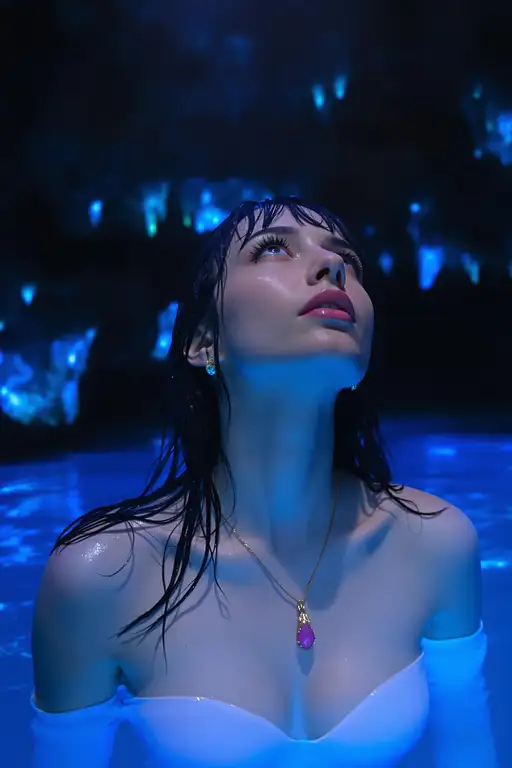
2 months ago
Ethereal woman age 24, Eastern European features with high cheekbones, long wet black hair, looking upward with parted pink lips, submerged to shoulders in glowing blue water, delicate gold pendant necklace with pink gem, white shoulders visible above water, beam of light illuminating pale skin from above, dark mystical cave with luminescent blue crystal formations, magical atmosphere, cinematic lighting, fashion photography style --ar 9:16 --v 6

5 months ago
A woman in a striking red steampunk-inspired outfit, adorned with intricate lace and metal accents, is submerged underwater. She wears large, vintage-style goggles on her head, with flowing, wavy hair that floats around her. The water is filled with bubbles and hints of machinery, including gears and pipes, creating a mysterious, industrial underwater environment. Her makeup is bold, featuring bright red lips and decorative face art. Soft, diffused light filters through the water, adding a magical quality to the scene. --style raw --v 6.1

7 months ago
Ethereal woman age 35, Eastern European features with high cheekbones, long wet black hair, looking upward with parted pink lips, submerged to shoulders in glowing blue water, delicate gold pendant necklace with pink gem, white shoulders visible above water, beam of light illuminating pale skin from above, dark mystical cave with luminescent blue crystal formations, magical atmosphere, cinematic lighting, fashion photography style --ar 9:16 --v 6
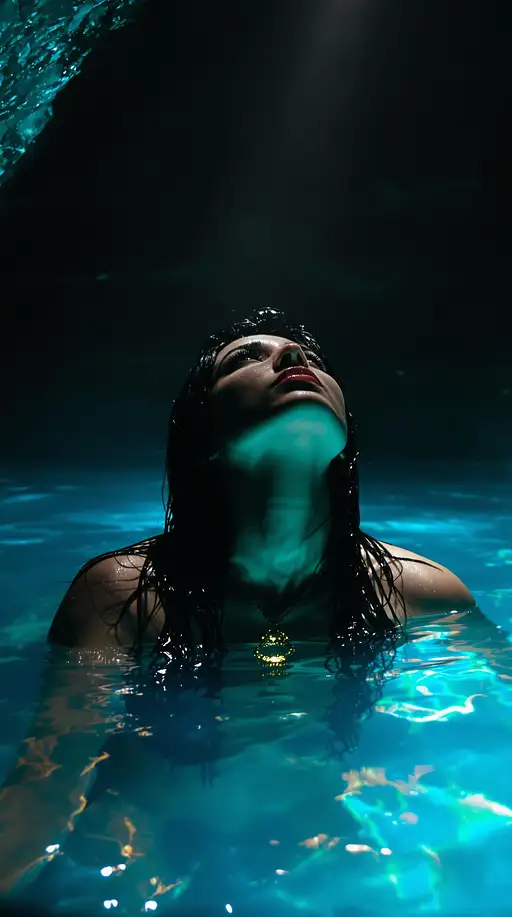
7 months ago
Woman in mystical cave pool, long wet black hair, looking upward with parted lips, submerged to shoulders in glowing blue water, gold pendant necklace, beam of light illuminating face from above, dark cave with crystal formations, magical atmosphere, cinematic lighting --ar 9:16 --v 6
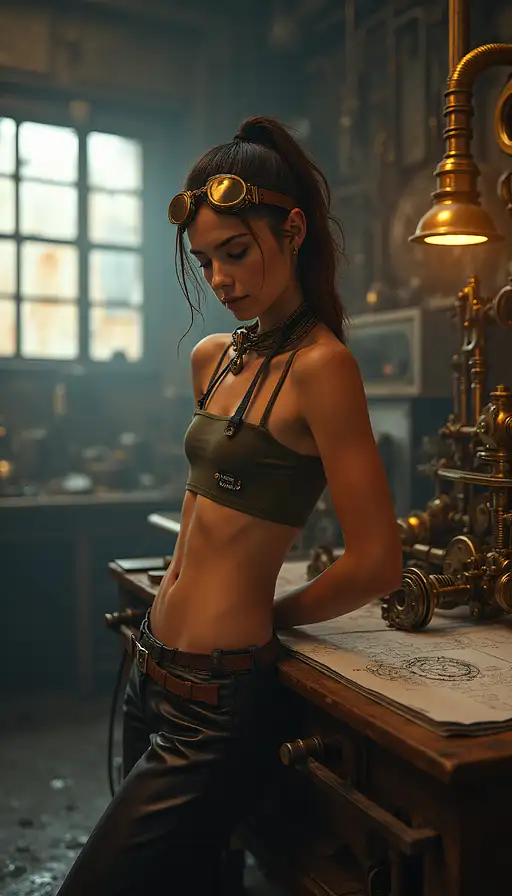
7 months ago
photo from Partially submerged in water with subject above waterline of a 24-year-old athletic female clockwork engineer working in her steampunk workshop, lean muscular physique with defined abs and strong arms, wearing fitted leather work pants and cropped workshop top that reveals her toned midriff, Layered cut in fall colors, longest layers resembling falling leaves hair partially tied back with brass goggles on forehead, concentrated expression as she adjusts intricate mechanical contraption, workshop filled with elaborate brass gears, steam pipes, and mechanical inventions, magical energy sources powering various devices with blue-gold glow, afternoon light streaming through large industrial windows illuminating floating dust particles, partially completed automaton assistants in background, workbench covered in blueprints and precision tools, small mechanical familiar perched on her shoulder, walls lined with intricate clock mechanisms and technical diagrams, highly detailed steampunk fantasy environment, artwork inspired by Stanley Artgerm Lau and Brian Kesinger, warm color palette with brass, copper and leather tones contrasted with cool magical energy accents, photorealistic rendering with dramatic workshop lighting highlighting muscle definition

8 months ago
A beautiful realistic portrait of a gorgeous fair-skinned blonde Irish woman gracefully reclining, half submerged in a peaceful rock pool. She has long light brown hair. She is wearing an elegant, very low-cut green dress that is very sheer and wet, clinging to her skin from the water that sparkles in the sunlight, its delicate fabric clinging to her shape and flowing into the water, and she is barefoot with beautiful, perfect feet, 5 toes on each foot. A small waterfall gently falls into the pool. All around her are beautiful colorful plants and flowers, their colors standing out against the earthy tones of the rocks. In the distance, familiar medieval Germany unfolds - a castle and an ancient kingdom basking in the direct sunlight. The scene is 8K, high resolution, highly detailed and high quality. Improve

7 months ago
The image depicts a serene landscape scene during sunset. The sky is painted with warm hues of orange and yellow, reflecting off the calm surface of a lake that mirrors the surrounding trees and clouds. The sun is partially hidden behind the treetops on the right side, casting long shadows and creating a soft glow across the entire scene. In the foreground, there's an abundance of daisies with white petals and bright yellow centers, adding vibrant color to the tranquil setting. The flowers are clustered together near the water’s edge, their stems partially submerged in the shallow water. On the left side of the image, tall grasses and reeds line the bank, leading up to a dense forest of deciduous trees. These trees display various shades of green, indicating different stages of foliage growth, possibly due to seasonal changes. Overall, the image captures a peaceful moment in nature, emphasizing the beauty of the natural world at dusk.
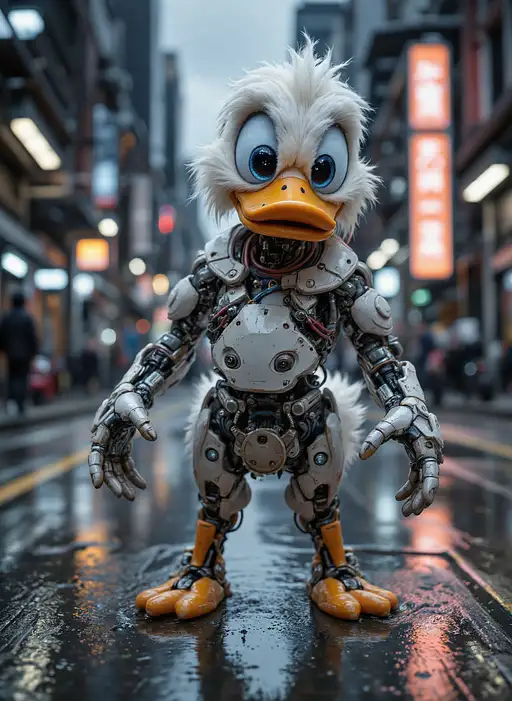
7 months ago
The image depicts a highly detailed and realistic rendering of Donald Duck, an iconic cartoon character. The duck is shown standing upright on a wet urban street, with its feet partially submerged in water. The background features blurred city buildings and lights, suggesting an evening or nighttime setting. Donald Duck's body is covered in intricate mechanical components, giving him a robotic appearance. His head retains his characteristic white feathers and bright orange beak, but the mechanical parts are prominently displayed. The chest area is adorned with various gears, wires, and metallic plates, while the arms and legs are similarly equipped with mechanical joints and segments. The hands and feet are also mechanical, with visible screws and bolts. The overall style of the image is a blend of realism and fantasy, combining the familiar elements of Donald Duck with advanced robotics to create a unique and visually striking portrayal.

7 months ago
a surreal and psychedelic scene, reminiscent of a Salvador Dali painting, where time and reality are distorted: In an expansive, dreamlike landscape, a clock melts over the edge of a table, defying the laws of physics. The sky above swirls with vibrant, otherworldly colors, blending into an infinite horizon. A figure stands at the center of this scene, their form shifting and changing. Parts of their body transform into various elements – one arm becomes a flowing river, the other a winding vine. Their face is a canvas of shifting expressions, each one reflecting a different aspect of human emotion. Around them, objects float in mid-air, defying gravity. Books open with pages turning into birds, a vintage telephone twists into a spiral, and a chessboard's pieces move on their own. In the background, a cityscape bends and curves like a wave, buildings morphing into surreal shapes. The border between sky and earth blurs, creating a sense of endlessness. In this scene, reality is malleable, and the ordinary becomes extraordinary. It's a visual representation of a mind-bending journey through a world where the impossible becomes possible, and the boundaries of imagination are limitless., moody, unsettling, surreal imagery, macabe, (award winning cinematic shot:1.21), (Kati Horna:1.32) From below, deep in the submerged grotto, a solitary figure stands at the water’s edge, gazing up toward the ascending steps, their expression contemplative and enigmatic. From above, another figure walks up the steps, seemingly unaware of the one below, their face obscured as if caught in a moment between reality and illusion. The water shimmers with an impossible clarity, revealing intricate, otherworldly details beneath the surface—perhaps submerged relics, mysterious symbols, or faint glimpses of an unseen world. The sky above is vast and surreal, with clouds that seem to defy gravity, casting an uncanny glow over the entire composition. The atmosphere is both hyper-detailed, in the style of van Eyck, and eerily mysterious, as if Magritte’s enigmatic vision has bent reality itself.

5 months ago
Create a meticulously staged cinematic scene with rigid symmetry and frontal, low-angle framing, emphasizing a diagonal composition (45-degree tilt) where all elements align along a single dynamic axis. Color Grading: 60% Dominant: Soft, powdery pastel pinks (Pantone 12-1109 TPX "Marshmallow") saturating the sky, snow, and TV casing. 30% Secondary: Frosted teal blues (HEX #6ECEDA) in the glacial lake, aurora, and TV screen static. 10% Accent: Mustard-yellow (Pantone 15-0950 TPX "Golden Glow") in the aurora streaks, wool tufts, and corroded metal knobs. TV Design: A 1950s Bakelite TV (matte eggshell plastic with hairline cracks) tilted diagonally (top-left corner at 10 o’clock, bottom-right submerged at 4 o’clock). Crack: A jagged diagonal fissure (2cm wide) splits the screen from top-left to bottom-right, leaking viscous, neon-bright color bar pigment (RGB values: pink #FF9EB5, teal #5FDAC3, gold #FFD700) that pools into the water below. Materials: Body: Faux-weathered plastic with chipped edges revealing rusted steel underlayers. Details: Three rotary knobs (tarnished brass, 4cm diameter) labeled "VOL," "TUNE," "POWER." Cables: Braided wool cords (undyed cream yarn, 3cm thickness) coiled around the TV’s base, fraying at the ends. Screen Imagery: Static Overlay: A 1953 RCA-style color bar test pattern (8 vertical bands) glitching every 2 seconds, causing the teal and pink bars to "melt" downward into liquid the word "Imagen-4" glitches on the screen Underlying Image: A faint, glowing topographical map (golden-yellow lines on indigo) dissolves into water that cascades from the screen’s crack, merging with the glacial lake. Environment: Glacial Lake: Semi-frozen water (translucent teal, 70% opacity) with jagged ice shards (20cm height) encircling the TV. Snowfall: Heavy, dense snowflakes (1cm diameter) falling at 45 degrees, accumulating on the TV’s top-left corner. Aurora Borealis: Three parallel bands (pink #FFB3D1, teal #7FE5E5, gold #FFE44D) in smooth sine waves, 15° tilt, 80% opacity. Sky: Ultra-high-contrast starfield (ISO 51200 noise pattern) with 2,000 visible stars (randomized 2-4px white dots). Lighting & Effects: Key Light: A frontal, low-orange sodium vapor lamp (3200K) casting sharp diagonal shadows (20° angle) from the TV onto the ice. Bloom: Halation around the aurora and screen, radius 15px, intensity 70%. Textures: Film Grain: 35mm Kodak Vision3 250D overlay (gritty, high-detail). Lens Defects: Two hairline scratches (1px width) at 15° and 75° angles, plus hexagonal lens flare (60% opacity) from the aurora. Physics & Motion: Water: Viscous fluid dynamics—the leaking color bars swirl in 5cm eddies, blending with the glacial lake. Wool: Submerged yarn floats upward in 10cm tufts, swaying at 0.5Hz frequency. Result: A hyper-detailed, reference-free scene that implicitly channels Wes Anderson’s aesthetic through obsessive symmetry, retro-kitsch materials, and a strict 60/30/10 pastel hierarchy—no director named, all style embedded in granular technical specs.

5 months ago
"Create a meticulously staged cinematic scene with rigid symmetry and frontal, low-angle framing, emphasizing a diagonal composition (45-degree tilt) where all elements align along a single dynamic axis. Color Grading: 60% Dominant: Soft, powdery pastel pinks (Pantone 12-1109 TPX "Marshmallow") saturating the sky, snow, and TV casing. 30% Secondary: Frosted teal blues (HEX #6ECEDA) in the glacial lake, aurora, and TV screen static. 10% Accent: Mustard-yellow (Pantone 15-0950 TPX "Golden Glow") in the aurora streaks, wool tufts, and corroded metal knobs. TV Design: A 1950s Bakelite TV (matte eggshell plastic with hairline cracks) tilted diagonally (top-left corner at 10 o’clock, bottom-right submerged at 4 o’clock). Crack: A jagged diagonal fissure (2cm wide) splits the screen from top-left to bottom-right, leaking viscous, neon-bright color bar pigment (RGB values: pink #FF9EB5, teal #5FDAC3, gold #FFD700) that pools into the water below. Materials: Body: Faux-weathered plastic with chipped edges revealing rusted steel underlayers. Details: Three rotary knobs (tarnished brass, 4cm diameter) labeled "VOL," "TUNE," "POWER." Cables: Braided wool cords (undyed cream yarn, 3cm thickness) coiled around the TV’s base, fraying at the ends. Screen Imagery: Static Overlay: A 1953 RCA-style color bar test pattern (8 vertical bands) glitching every 2 seconds, causing the teal and pink bars to "melt" downward into liquid with the word "Prompthero" barely visible on it. Underlying Image: A faint, glowing topographical map (golden-yellow lines on indigo) dissolves into water that cascades from the screen’s crack, merging with the glacial lake. Environment: Glacial Lake: Semi-frozen water (translucent teal, 70% opacity) with jagged ice shards (20cm height) encircling the TV. Snowfall: Heavy, dense snowflakes (1cm diameter) falling at 45 degrees, accumulating on the TV’s top-left corner. Aurora Borealis: Three parallel bands (pink #FFB3D1, teal #7FE5E5, gold #FFE44D) in smooth sine waves, 15° tilt, 80% opacity. Sky: Ultra-high-contrast starfield (ISO 51200 noise pattern) with 2,000 visible stars (randomized 2-4px white dots). Lighting & Effects: Key Light: A frontal, low-orange sodium vapor lamp (3200K) casting sharp diagonal shadows (20° angle) from the TV onto the ice. Bloom: Halation around the aurora and screen, radius 15px, intensity 70%. Textures: Film Grain: 35mm Kodak Vision3 250D overlay (gritty, high-detail). Lens Defects: Two hairline scratches (1px width) at 15° and 75° angles, plus hexagonal lens flare (60% opacity) from the aurora. Physics & Motion: Water: Viscous fluid dynamics—the leaking color bars swirl in 5cm eddies, blending with the glacial lake. Wool: Submerged yarn floats upward in 10cm tufts, swaying at 0.5Hz frequency. Result: A hyper-detailed, reference-free scene that implicitly channels Wes Anderson’s aesthetic through obsessive symmetry, retro-kitsch materials, and a strict 60/30/10 pastel hierarchy—no director named, all style embedded in granular technical specs.
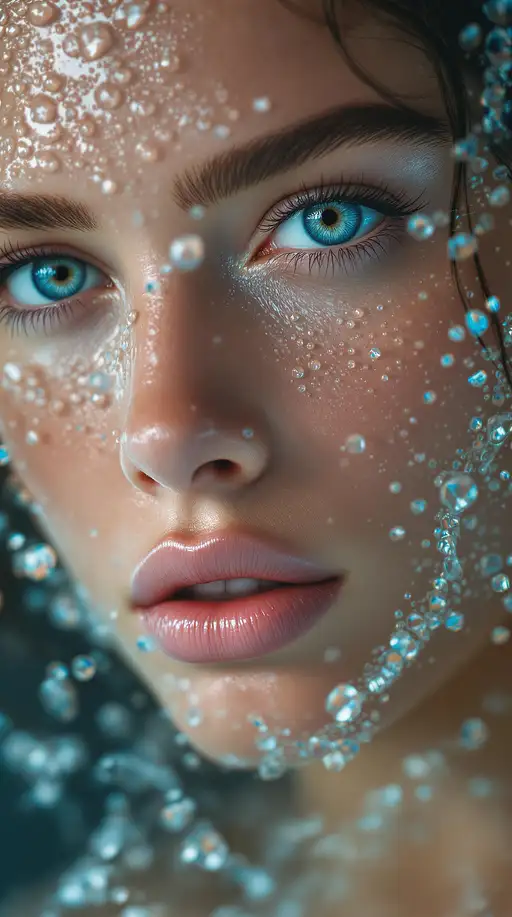
3 months ago
"Image is a captivating high resolution close up portrait photograph captured with a Sony A1 camera. Featuring a beautiful lithe supermodel in her early 20s, submerged in water, highlighting crystal clear drops and streams gliding across her skin. She has extremely detailed large, intense, piercing vibrant sapphire blue silver grey eyes staring directly into the lens. The water acts both as a veil and amplifier, enhancing the textures and fine details of the skin, while evoking a serene, ethereal quality.”
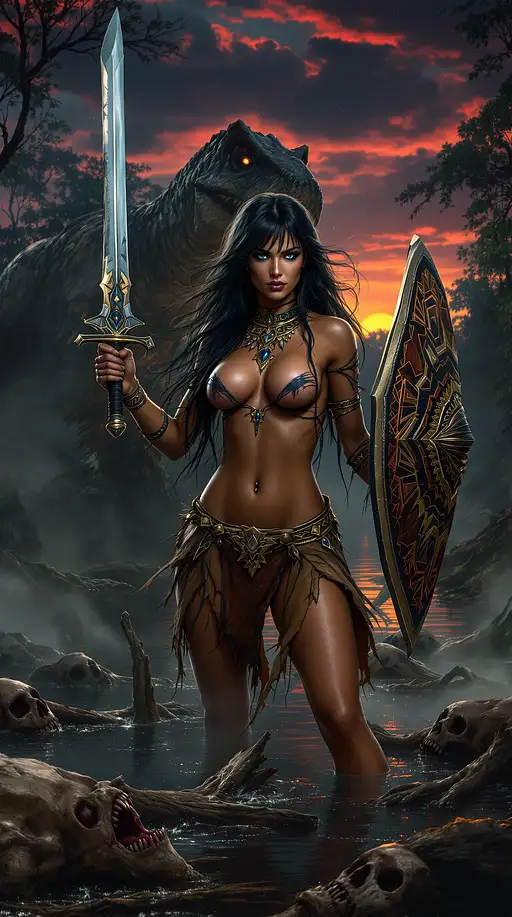
2 months ago
Hyper realistic, photo realism, High Contrast, insanely detailed and intricate, elegant, ornate, super detailed zoomed out full body HD Photo of beautiful, native warrior woman, with high contrast, the woman has an aggressive expression, she holds her shield up to block the axe of her enemy, while at the same time decapitating her enemy with her sword. There are bodies of her enemies laying all around her in the swamp. Her tyrannosaurus rex stands behind her protecting her from behind. skeletons and broken mosey tree trunks with dead warriors submerged in the water. The swamp bubbles up steam causing a light fog. The woman warrior has long black hair with bangs blowing in the wind, dark sapphire blue eyes, the woman's eyes are framed by long, elegant eyelashes and ornate eyeshadow that compliments her eyes. The woman wears animal hide top, bare midriff, ragged hide mini skirt with ornate gold belt and choker. It is night. There are dark clouds moving in on the Reddish, purple, and Orange sunset and the jungle with big trees and vines in the background. No poorly formed fingers, no extra arms, no extra legs, no extra fingers, no poorly formed hands, no poorly drawn body, no poorly drawn teeth, no bad anatomy.
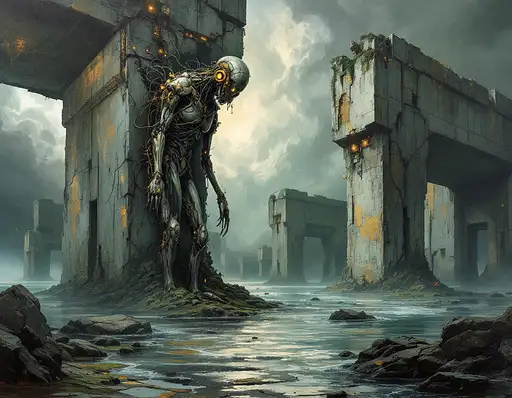
6 months ago
In a drowned brutalist cityscape, towering monolithic concrete structures loom half-submerged beneath dark, stormy waters. Their fractured surfaces are coated in thick, swirling impasto oil strokes—chaotic colors of muted mossy green, oxidized gray, and faded gold, battling against the stark brutality of the architecture. Around the ruins, colossal biomechanical figures rise from the depths—surreal amalgamations of fossilized bone, cracked brass, and ember-lit circuitry, warped and twisted by unseen tectonic forces into sacred, monstrous forms.
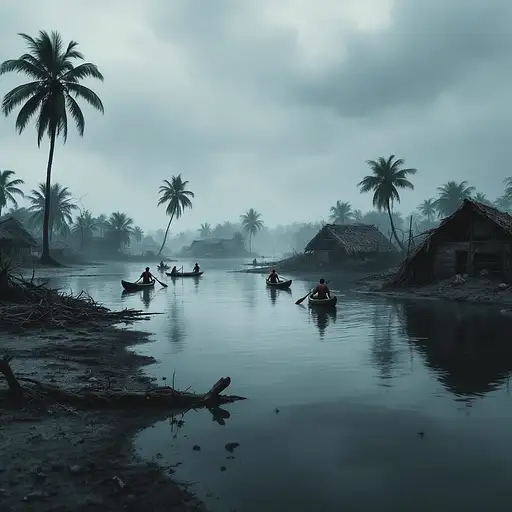
8 months ago
"A haunting 4K depiction of a degraded mangrove swamp, showing the devastating impact of environmental destruction. The once-thriving shoreline is now eroded, with skeletal remains of trees jutting out from the encroaching sea. Palm trees, half-submerged, lean precariously as rising waters consume the land. The village is desolate and abandoned, its wooden huts broken and overtaken by nature. In the murky waters, a few local men in tattered clothing paddle their canoes, desperately fishing in the ruined ecosystem. The atmosphere is grim and overcast, with mist rolling over the water, evoking a sense of loss and struggle. The art style mirrors the raw, cinematic realism of The Revenant, with dramatic lighting, rich earthy textures, and an immersive sense of despair and resilience."

8 months ago
best quality,(limited palette,gouache \(medium\):1.1),deep blue theme, (solo,chibi:1.2),cat ears,closed eyes,hugging cat,(partially submerged:1.1), outdoors,landscape,scenery,(reflective water:0.9), <lora:hyperrefiner_v090:1.0>

8 months ago
best quality,(limited palette,gouache \(medium\):1.1),deep blue theme, (solo,chibi:1.2),cat ears,closed eyes,hugging cat,(partially submerged:1.1), outdoors,landscape,scenery,(reflective water:0.9), <lora:hyperrefiner_v090:1.0>

8 months ago
A captivating portrait of a young Egyptian woman reclining gracefully, half-submerged in a tranquil ancient rock pool. She wears an elegant, translucent gown that shimmers in the sunlight, its delicate fabric clinging to her form and flowing into the water like liquid gold. barefoot A small waterfall cascades gently into the pool, its sound soft and soothing. Surrounding her are lush, exotic plants and vibrant flowers, their colours vivid against the earthy tones of the rocks. In the hazy distance, the grandeur of ancient Egypt unfolds—pyramids, temple ruins, and the faint silhouette of a grand city basking in the golden light of the desert sun. The scene is rich with intricate details, blending serenity and opulence, evoking the timeless beauty of Egyptian culture
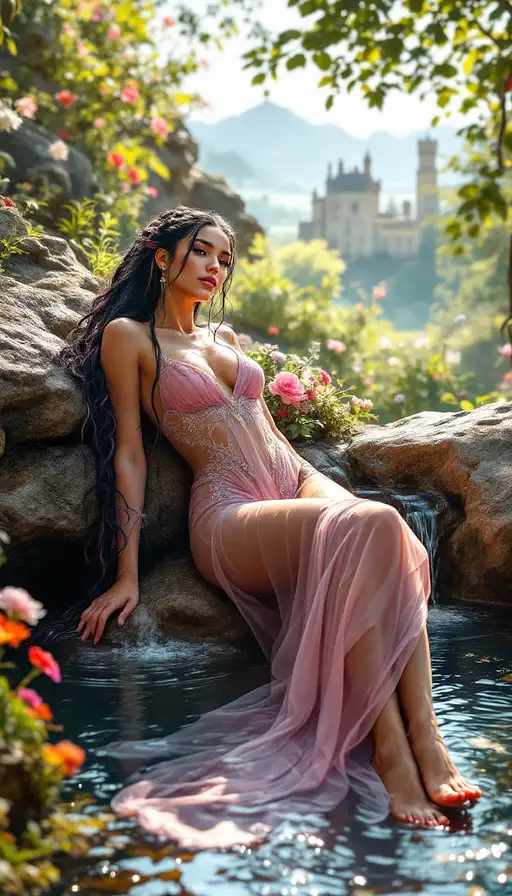
7 months ago
A beautiful realistic portrait of a gorgeous Irish female reclining gracefully, half-submerged in a tranquil rock pool. She has long, braided raven black and pink mixed hair. She wears an elegant, sheer pink gown that shimmers in the sunlight, its delicate fabric clinging to her form and flowing into the water, and barefoot. A small waterfall cascades gently into the pool. Surrounding her are beautiful plants and colorful flowers, their colours stand out against the earthy tones of the rocks. In the distance, well known midevil England unfolds—castle and an old kingdom basking in the direct light of the sun. The scene 8K, high resolution, highly detailed, and high quality.
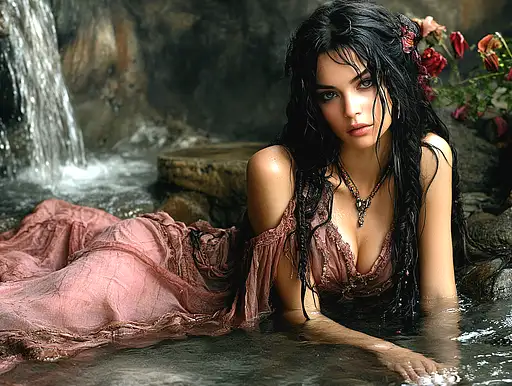
8 months ago
A beautiful realistic portrait of a pale ivory skin tone female reclining gracefully, half-submerged in a tranquil ancient rock pool. She has long, braided raven black and pink mixed hair. She wears an elegant, sheer pink gown that shimmers in the sunlight, its delicate fabric clinging to her form and flowing into the water, and barefoot. A small waterfall cascades gently into the pool. Surrounding her are beautiful plants and colorful flowers, their colours stand out against the earthy tones of the rocks. In the distance, well known midevil England unfolds—castle and an old kingdom basking in the direct light of the sun. The scene 8K, high resolution, highly detailed, and high quality.

8 months ago
This is a highly detailed, digital photograph featuring an East Asian woman submerged in a deep blue pond. The woman's complexion is fair, with smooth skin and a serene expression. Her dark, straight hair is slicked back and adorned with a single bright yellow lotus flower. Her eyes are strikingly blue, accentuated with bold, turquoise eyeshadow that matches the water's color. She wears no visible clothing, and her shoulders and upper chest are visible, hinting at a slender physique. The pond water is clear, with a slight ripple around her, and is dotted with large, round lily pads of various sizes. The lily pads are a vibrant green, contrasting with the blue water and her skin tone. The background is dark and indistinct, focusing attention on the woman and the pond. The image captures a tranquil, almost ethereal mood, with a strong emphasis on natural beauty and serenity. The lighting is soft and diffused, likely achieved with a high-quality digital camera and skilled post-processing. The overall composition and color palette create a harmonious and dreamlike atmosphere., Fashion photography, surrealistic, hyper-realistic, photorealism, high resolution, shot using a Canon EOS R5 F2 ISO300
Create a PromptHero account to save favorites, generate images, and discover AI artists you'll love.
Join a vibrant community of thousands of AI enthusiasts like you.
Already a member? Log in. By creating an account, you agree to our Terms Of Service, and to receive emails and updates.